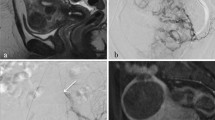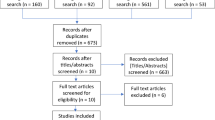Abstract
Purpose
To assess uterine artery recanalization, together with tumor devascularization, after embolization using gelatin sponge particles alone for fibroids.
Methods
Twenty-seven patients underwent uterine artery embolization (UAE) for fibroids using only gelatin sponge particles. The angiographic endpoint of embolization was defined as near stasis of contrast medium in the ascending segment of the uterine artery. All patients underwent contrast-enhanced magnetic resonance angiography (MRA) before and 4 months after UAE, and contrast-enhanced magnetic resonance imaging (CE-MRI) before, 1 week after, and 4 months after UAE. The visualization of the uterine arteries before and 4 months after UAE was assessed using MRA. The infarction rates of the largest tumor were assessed using CE-MRI 1 week after UAE.
Results
MRA 4 months after UAE showed 100% (53/53) of the descending and transverse segments, and 88% (43/49) of the ascending segments that had been noted on baseline MRA. The visualization of the ascending segments on MRA 4 months after UAE was identical to that on baseline MRA in 20 of 27 patients (74%). CE-MRI showed complete infarction of the largest tumor in 22 of 27 patients (81%), and 90–99% infarction of the largest tumor in the remaining 5 of 27 patients (19%).
Conclusion
Based on the MR study, in most cases uterine artery recanalization occurred, together with sufficient devascularization of fibroids, after UAE using gelatin sponge particles alone.


Similar content being viewed by others

References
Ravina JH, Herbreteau D, Ciraru-Vigneron N, et al. (1995) Arterial embolisation to treat uterine myomata. Lancet 346:671–672
Worthington-Kirsch RL, Popky GL, Hutchins FL Jr (1998) Uterine arterial embolization for the management of leiomyomas: Quality-of-life assessment and clinical response. Radiology 208:625–629
Pelage JP, Le Dref O, Soyer P, et al. (2000) Fibroid-related menorrhagia: Treatment with superselective embolization of the uterine arteries and midterm follow-up. Radiology 215:428–431
Pron G, Bennett J, Common A, et al. (2003) The Ontario uterine fibroid embolization trial. 2. Uterine fibroid reduction and symptom relief after uterine artery embolization for fibroids. Fertil Steril 79:120–127
Goodwin SC, McLucas B, Lee M, et al. (1999) Uterine artery embolization for the treatment of uterine leiomyomata: Midterm results. J Vasc Interv Radiol 10:1159–1165
Spies JB, Ascher SA, Roth AR, et al. (2001) Uterine artery embolization for leiomyomata. Obstet Gynecol 98:29–34
Walker WJ, Pelage JP (2002) Uterine artery embolisation for symptomatic fibroids: Clinical results in 400 women with imaging follow up. Br J Obstet Gynecol 109:1262–1272
Pelage JP, Guaou NG, Jha RC, et al. (2004) Uterine fibroid tumors: Long-term MR imaging outcome after embolization. Radiology 230:803–809
Chrisman HB, West D, Corpuz B, et al. (2005) Primary failure of uterine artery embolization: Use of magnetic resonance imaging to select patients for repeated embolization. J Vasc Interv Radiol 16:1143–1147
Spies JB (2003) Uterine artery embolization for fibroids: Understanding the technical causes of failure. J Vasc Interv Radiol 14:11–14
Marret H, Alonso AM, Cottier JP, et al. (2003) Leiomyoma recurrence after uterine artery embolization. J Vasc Interv Radiol 14:1395–1399
Katsumori T, Kasahara T, Akazawa K (2006) Long-term outcomes of uterine artery embolization using gelatin sponge particles alone for symptomatic fibroids. AJR Am J Roentgenol 186:848–854
Katsumori T, Nakajima K, Tokuhiro M (2001) Gadolinium-enhanced MR imaging in the evaluation of uterine fibroids treated with uterine artery embolization. AJR Am J Roentgenol 177:303–307
Katsumori T, Nakajima K, Mihara T, et al. (2002) Uterine artery embolization using gelatin sponge particles alone for symptomatic uterine fibroids: Midterm results. AJR Am J Roentgenol 178:135–139
Willinek WA, Gieseke J, Conrad R, et al. (2002) Randomly segmented central k-space ordering in high-spatial-resolution contrast-enhanced MR angiography of the supraaortic arteries: Initial experience. Radiology 225:583–588
Vlahos L, Benakis V, Dimakakos P, et al. (1980) A comparative study of the degree of arterial recanalization in kidneys of dogs following transcatheter embolization with eight different materials. Eur Urol 6:180–185
Sniderman KW, Sos TA, Alonso DR (1981) Transcatheter embolization with gelfoam and avitene: The effect of sotradecol on the duration of arterial occlusion. Invest Radiol 16:501–507
Gold RE, Grace DM (1975) Gelfoam embolization of the left gastric artery for bleeding ulcer: Experimental consideration. Radiology 116:575–580
Correll JT, Prentice HR, Wise EC (1945) Biological investigations of a new absorbable sponge. Surg Gynecol Obstet 81:585–589
Jander HP, Russinovich NA (1980) Transcatheter gelfoam embolization in abdominal, retroperitoneal, and pelvic hemorrhage. Radiology 136:337–344
Razavi MK, Rhee J, Sze DY, et al. (2000) Recanalization of uterine arteries after embolization for symptomatic leiomyomas: evidence on MRA. J Vasc Interv Radiol Suppl 11:286
Spies JB, Allison S, Flick P, et al. (2005) Spherical polyvinyl alcohol versus tris-acryl gelatin microspheres for uterine artery embolization for leiomyomas: Results of a randomized comparative study. J Vasc Interv Radiol 16:1431–1437
Prince MR, (1994) Gadolinium-enhanced MR aortography. Radiology 191:155–164
Yamashita Y, Mitsuzaki K, Ogata I, et al. (1998) Three-dimensional high-resolution dynamic contrast-enhanced MR angiography of the pelvis and lower extremities with use of a phased array coil and subtraction: Diagnostic accuracy. J Magn Reson Imaging 8:1066–1072
Winterer JT, Laubenberger J, Scheffler, et al. (1999) Contrast-enhanced subtraction MR angiography in occlusive disease of the pelvic and lower limb arteries: Results of a prospective intraindividual comparative study with digital subtraction angiography in 76 patients. J Comput Assist Tomogr 23:583–589
Ruehm SG, Hany TF, Pfammatter T, et al. (2000) Pelvic and lower extremity arterial imaging: Diagnostic performance of three-dimensional contrast-enhanced MR angiography. AJR Am J Roentgenol 174:1127–1135
Author information
Authors and Affiliations
Corresponding author
Rights and permissions
About this article
Cite this article
Katsumori, T., Kasahara, T., Kin, Y. et al. Magnetic Resonance Angiography of Uterine Artery: Changes with Embolization Using Gelatin Sponge Particles Alone for Fibroids. Cardiovasc Intervent Radiol 30, 398–404 (2007). https://doi.org/10.1007/s00270-006-0196-3
Published:
Issue Date:
DOI: https://doi.org/10.1007/s00270-006-0196-3



